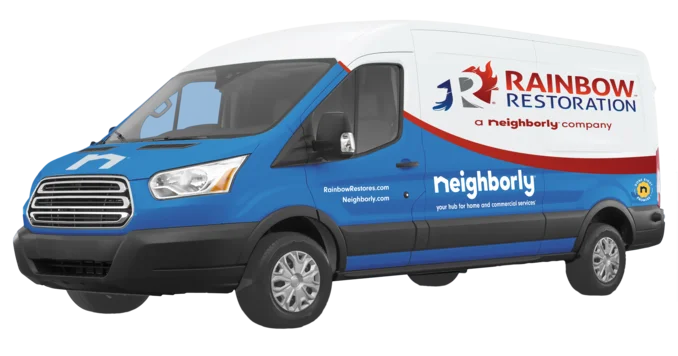October is Fire Prevention Month! Rainbow Restoration presents 7 key fire prevention steps property owners can take to prepare.
|
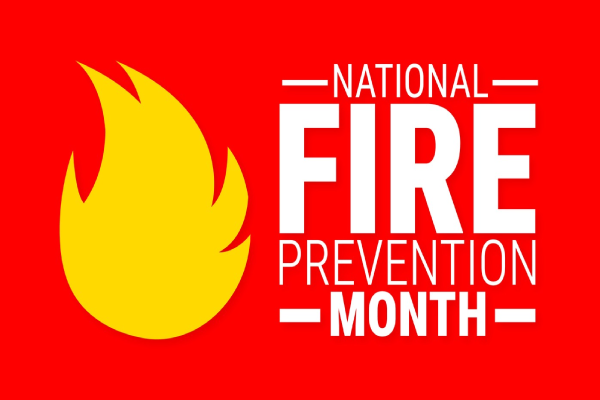
When the leaves begin to turn and the air grows crisp, your thoughts may turn to cozy sweaters and pumpkin spice. As restoration experts, Rainbow Restoration professionals view October a little differently. Since October is Fire Prevention Month, we see it as the most critical time of the year to stress the importance of preparedness.
This guide provides expert advice on fire safety month preparedness, including the most common home fire hazards and seven proactive steps you can take to maximize your household’s safety during fire season.
- The Most Common Fire Hazards in Homes and Businesses
- Step 1: Smoke Alarm and CO Detector Protection
- Step 2: Develop and Practice a Fire Escape Plan
- Step 3: Cook with Caution
- Step 4: Inspect and Maintain Heating Systems and Appliances
- Step 5: Check Your Electrical System for Overload and Damage
- Step 6: Get the Right Fire Extinguishers (And Know How to Use Them)
- Step 7: Address Unique Lifestyle Hazards
- When Prevention Meets Restoration
- Fire Safety Month FAQ
The Most Common Fire Hazards in Homes and Businesses
Before you can begin protecting against fire hazards, you’ll need to know how to identify the greatest risks. Understanding these hazards is the first step in your fire prevention month preparation.
Three primary causes of home fires
Data from the U.S. Fire Administration (USFA) shows that three causes consistently lead to the most residential fires:
- Cooking: Unattended cooking is the primary cause of home fires. A grease fire can ignite and spread in seconds, and adding water can make it worse.
- Heating equipment: As temperatures drop, homeowners rely on furnaces, space heaters, and fireplaces. Faulty equipment and poor heater placement are major fire hazards.
- Electrical malfunction: Old wiring, overloaded circuits, and the improper use of extension cords can lead to electrical fires.
Top causes of commercial property fires
Fire risks for businesses often mirror residential hazards but are amplified by scale, specialized equipment, and greater foot traffic. The leading causes of non-residential fires are:
- Commercial cooking: Grease accumulation in hood suppression systems and exhaust vents is a prime catalyst for fires.
- Electrical and lighting equipment: Commercial properties utilize complex and demanding electrical systems. Faulty wiring, old or defective lighting, and overloaded circuits are major hazards.
- Arson: Intentional fires account for a large number of incidents in non-residential properties, including warehouses, offices, and educational buildings.
- Heating equipment: Faulty commercial boilers, furnaces, and the misuse of portable space heaters in offices increase fire risks when improperly maintained or operated.
Step 1: Smoke Alarm and CO Detector Protection
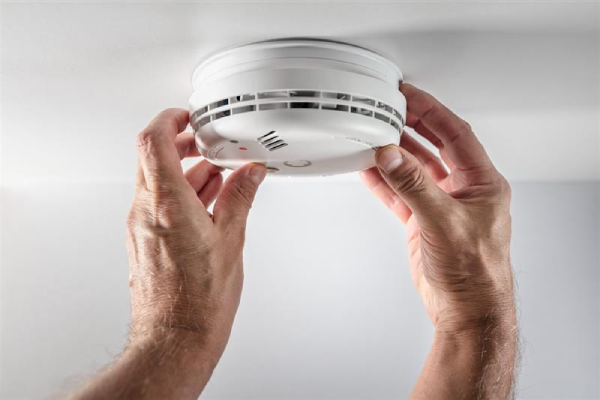
Smoke alarms are the first line of defense against fires. In fact, a working smoke alarm can significantly increase your chances of surviving a house fire. Fire-related deaths occur most often in homes with no working alarms.
Replace every 10 years
Smoke alarms don’t last forever! The U.S. Fire Administration recommends replacing all smoke detectors every 10 years.
- Check the date: Look for the date stamped on the back of the unit. If you can’t find it, assume the alarm is out of date and replace it.
- Test monthly: Push the test button on every alarm at least once a month.
- Change batteries annually: Use Fire Prevention Month in October as your annual reminder to swap out batteries in units that don't have sealed, long-life batteries.
Utilize strategic placement
Don't guess where to put your alarms. Follow National Fire Protection Association (NFPA) guidelines and place a smoke alarm:
- On every level of your home, including the basement,
- Inside every bedroom, and
- In the hallway or area immediately outside of all sleeping areas.
Remember to install carbon monoxide (CO) detectors outside of sleeping areas, especially if you have fuel-burning appliances or an attached garage.
Step 2: Develop and Practice a Fire Escape Plan
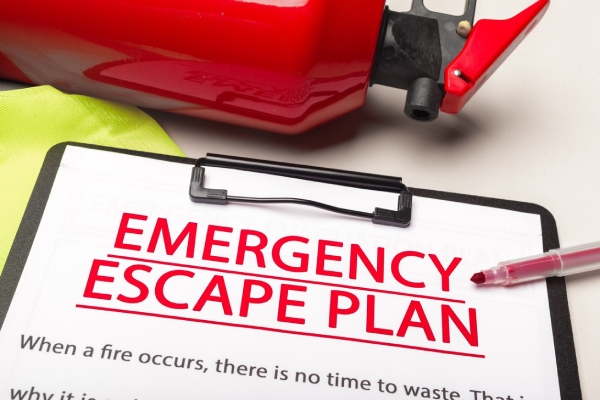
Fires can grow from a small flame to a major incident in under 30 seconds. An established fire escape plan can help save lives in the event of a structural fire.
Households should practice a fire escape plan with all family members at least twice a year. Practice both during the day and at night to simulate different conditions. Ensure that everyone knows two ways out of every room and is aware of the location of your designated outside meeting place.
The Family Fire Drill ChecklistMap it out: Draw a floor plan of your home, marking all doors and windows. Show two ways out of every room. Establish a meeting place: Choose a spot outside, away from the home (like a neighbor’s driveway or a light post), where everyone can meet to ensure accountability. Practice: Drill the plan at least twice a year. Practice both during the day and at night when visibility is low. Teach kids the basics: Instruct children to crawl low under smoke and to never go back inside for people or pets. Test window/door access: Make sure all windows open easily and are not painted shut. Ensure security bars have emergency quick-release latches. |
Step 3: Cook with Caution
As the most common source of house fires, the kitchen deserves the most scrutiny during fire safety month.
- Stay attentive. Never leave cooking food unattended, especially when frying, grilling, or broiling. If you must leave the kitchen, turn off the stove.
- Clear the clutter. Keep all combustibles (oven mitts, wooden utensils, towels, curtains, food packaging) at least three feet away from the stovetop.
- Check your vent filters. Clean or replace stove hood vent filters every six months. Clogged vents can lead to grease in the vent motor, which creates a fire risk.
- Handle grease fires correctly. If a grease fire starts, do not douse it with water. Turn off the heat and smother the flames using a lid, baking soda, or a fire extinguisher.
Step 4: Inspect and Maintain Heating Systems and Appliances
Heading into the colder months means turning up the heat—and the fire risk. Faulty or improperly used heating equipment is the second most common cause of home fires, according to the American Red Cross.
Heating Appliance Fire Safety Month ChecklistFurnace/HVAC: Schedule a professional inspection and cleaning before the heating season begins. Space heaters: Use the “Three-Foot Rule”—keep space heaters at least three feet from anything flammable. Plug them directly into a wall outlet, never an extension cord. Fireplaces/Chimneys: Have your chimney and vents professionally cleaned and inspected. Use a metal screen to prevent sparks from escaping. Clothes dryers: Clean the lint filter after every single use. Have the dryer vent ductwork professionally inspected and cleaned to remove trapped lint. |
Step 5: Check Your Electrical System for Overload and Damage
The electrical system is often an invisible fire threat. Many older homes are not equipped to handle the demands of modern electronics and appliances, which can lead to overheating.
Electrical Hazard ChecklistCircuit overload prevention Plug electronics into power strips with surge protection, not basic extension cords. Strictly avoid daisy-chaining (plugging one power strip into another). Plug high-wattage appliances (space heaters, refrigerators, microwaves) directly into a wall outlet. Ensure all outlets are utilized only to their safe capacity (avoid drawing excess power from a single point). Cord and device inspection Regularly check all appliance and extension cords for fraying, cracking, or exposed wiring. Replace (don’t tape) any damaged or malfunctioning cords immediately. Use extension cords only as a temporary measure, never as a permanent wiring solution. Signs to call a qualified electrician immediately An outlet or switch plate is hot to the touch. Lights flicker frequently, especially when an appliance is turned on. Fuses blow repeatedly, or circuit breakers trip often. A persistent burning or smoky odor comes from any outlet, appliance, or area of the wall. |
Step 6: Get the Right Fire Extinguishers (And Know How to Use Them)
Detection (smoke alarms) and a plan (escape route) are vital, but so is having the tools to stop a small fire before it becomes a disaster. National Fire Prevention Month is the perfect reminder to buy, place, and learn to use extinguishers.
Selecting and placing home extinguishers
For residential use, look for a multipurpose, ABC-rated fire extinguisher. The “ABC” rating means it is effective on the three most common fire types:
- A: Ordinary combustibles (wood, paper, cloth)
- B: Flammable liquids (propane, oil, paint)
- C: Electrical equipment (wiring, appliances)
Place extinguishers in high-risk areas, such as the kitchen, laundry room, garage, and workshop. Mount them near an exit for easy retrieval.
The P.A.S.S. method
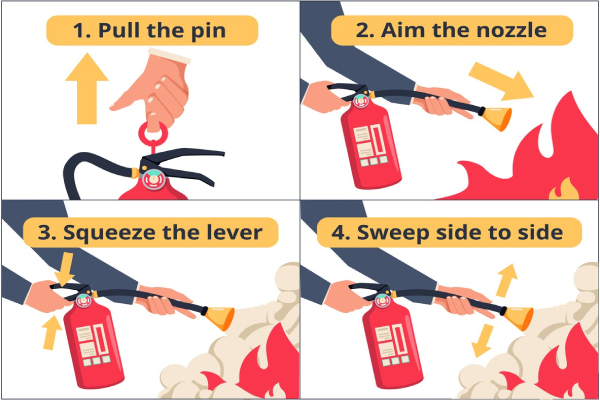
Simply owning an extinguisher is not the same as knowing how to use it effectively. The P.A.S.S. method is an easy way to remember the correct technique:
- Pull the pin.
- Aim the nozzle at the base of the fire.
- Squeeze the handle.
- Sweep the nozzle from side to side.
Note: Only attempt to extinguish a fire if it’s contained (such as in a wastebasket or a cooking pot), you have a clear escape route behind you, and your extinguisher is fully charged and rated for the correct type of fire. When in doubt, get out and call 911.
Step 7: Address Unique Lifestyle Hazards
Prevention involves more than just appliances. Many unique lifestyle choices introduce risks that should be addressed as part of your comprehensive fire safety month audit.
Lifestyle Fire Risk ChecklistCandle safety Keep all candles at least 12 inches away from anything that can burn. Always extinguish candles before leaving a room or going to sleep. Consider using flameless, battery-operated alternatives. Smoking materials If smoking indoors, use deep, sturdy ashtrays. Smoke outdoors and fully douse butts with water before disposal. Children and fireplay Store matches and lighters in a locked cabinet, out of the reach and sight of children. Educate your children about the dangers of fire and what to do if they see one. Outdoor flammables Ensure propane tanks, gasoline, and other flammable liquids are stored safely outside, away from the building and any heat sources. |
When Prevention Meets Restoration
At the core of October’s Fire Prevention Month education is the understanding that accidents can still happen. The steps outlined above provide a reliable defense against fires, but they are not a guarantee.
When fire, smoke, and soot damage occur, the result can feel overwhelming. As a residential and commercial fire damage restoration service, we understand both the property devastation and the complex, emotional recovery process that follows a fire.
Rainbow Restoration professionals handle everything from securing the property and eliminating smoke odors to contents restoration. Call your local Rainbow Restoration team to request service for property that has been damaged by fire and smoke. We offer 24/7 emergency services designed to address your needs promptly.
This article is intended for general informational purposes only and may not be applicable to every situation. You are responsible for determining the proper course of action for your home and property. Rainbow Restoration is not responsible for any damages that occur as a result of this blog content or your actions. For the most accurate guidance, call the Rainbow Restoration location nearest you for a comprehensive, on-site assessment.
Fire Safety Month FAQ
Setting the highest standards in water, fire, and mold damage restoration requires a continuous dedication to education and improvement. This commitment to exceptional service also includes using our years of experience and expertise to answer your restoration questions. Here are answers to some of the most frequently asked questions about fire prevention month.
Why is the kitchen considered the leading cause of house fires?
Most house fires start in the kitchen primarily due to unattended cooking, which can result in grease fires or ignitions from combustible materials left too close to the stove. Always stay in the kitchen when frying, grilling, or boiling food. Keep flammables like towels and curtains at least three feet from heat sources.
Why can’t water put out a grease fire?
Water applied to hot grease causes the oil to splatter, spreading the fire rapidly. It should never be used to put out a grease fire, as it can quickly make the situation worse.
If a grease fire is contained (such as in a frying pan), turn off the heat immediately and slide a lid over the pan to smother the flames. Baking soda or a Class K fire extinguisher can also be used safely. If the fire is not contained, call 911.
What causes dryer fires?
Dryer fires are frequently caused by the accumulation of flammable lint in the dryer vent duct. Over time, lint blocks airflow, causing heat to accumulate until the lint combusts.
To avoid a dryer fire, clean the lint filter after every load of laundry. Additionally, ensure the dryer vent ductwork is professionally inspected and cleaned at least once a year to remove lint buildup.
What does the “ABC” rating on a fire extinguisher mean?
The “ABC” rating means the extinguisher is effective on the three most common classes of household fires:
- A for ordinary combustibles (wood, paper, cloth)
- B for flammable liquids (paint, propane, gasoline)
- C for energized electrical equipment
An ABC extinguisher offers the most versatile protection for your home. Commercial properties may use the following classes of extinguishers:
- K for commercial cooking media (grease, oils, fats)
- D for combustible metals (magnesium, lithium, potassium)
Is it safe for me to clean up soot and smoke damage myself?
No. Soot is toxic and requires specialized personal protective equipment (PPE) and cleaning agents. Improper cleaning, like wiping walls with water, can smear the soot, driving it deeper into porous surfaces and permanently compounding the damage, making professional restoration more challenging and costly later.
If your property experiences a fire, call 911 immediately. Once emergency responders allow access to the scene, Rainbow Restoration’s expert service professionals can begin the process of cleaning up soot, smoke, and fire damage. We will work to restore your property to its best possible condition.
